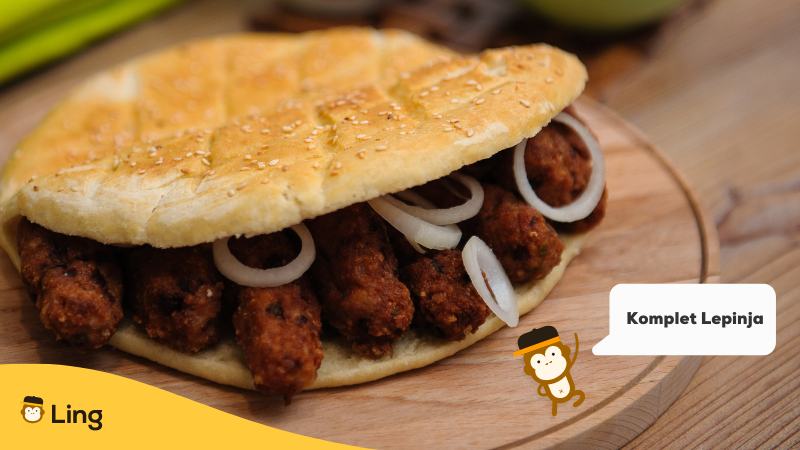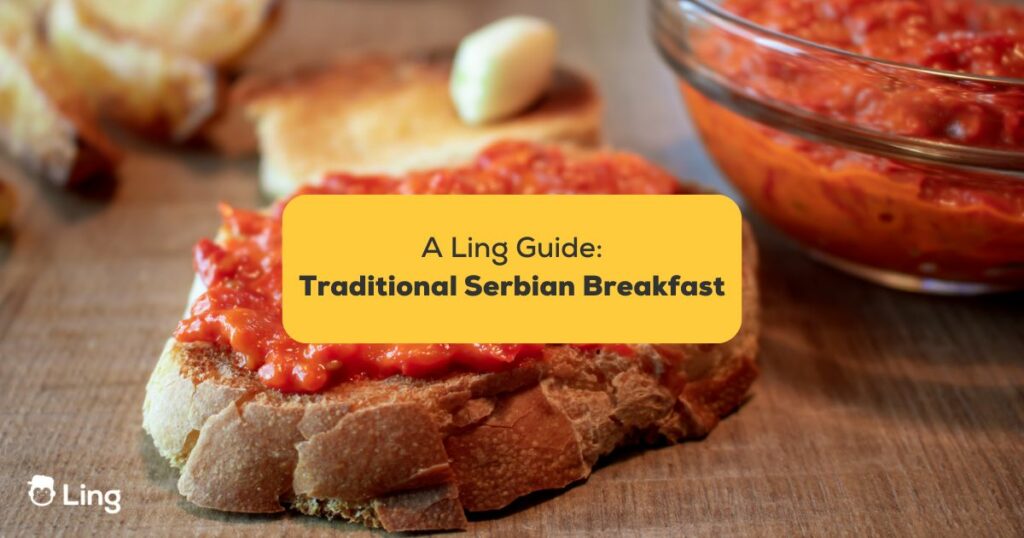Let’s talk about a culinary experience that’s near and dear to my heart: Traditional Serbian Breakfast. Why? Well, apart from the fact that breakfast is the most important meal of the day, Serbian breakfasts are just on a league of their own. I’m talking about flavorful dishes that’ll absolutely make your taste buds go “oh la la” in a snap!
So, if you ever find yourself in this country, do yourself a favor and seek out a traditional breakfast. Trust me, it’s an experience you won’t soon forget. And hey, while you’re at it, why not learn a few Serbian phrases to really impress your hosts?
Table Of Contents
Traditional Serbian Breakfast Food
Komplet Lepinja
The exact origins of komplet lepinja remain unclear, but it has been a staple of Serbian cuisine for many generations. It is particularly associated with the city of Užice in western Serbia where it is considered a local specialty.
One of the defining characteristics of komplet lepinja is its hearty and filling nature. The combination of carbohydrates from the bread protein from the eggs and sausages, and fat from the kajmak and cheese provides a satisfying and energizing meal. This makes it an ideal breakfast food for those facing a long day of work or activity. What could be better?
In addition to its nutritional value komplet lepinja is prized for its taste and texture. The slightly chewy texture of the lepinja contrasts nicely with the creamy kajmak and the savory flavors of the other fillings. The dish is often served hot, allowing the flavors to meld together.
While komplet lepinja is most commonly associated with breakfast it is also enjoyed at other times of the day. It is not uncommon to find it served as a quick lunch or even as a late-night snack. Its portability and ease of preparation make it a convenient choice for many occasions. A true all-day dish.

Gibanica
Gibanica is a traditional Serbian pastry dish often served for breakfast. It is a type of savory pie made with phyllo dough and a filling typically consisting of cheese, eggs, and sometimes meat.
The cheese used in gibanica is usually a mixture of soft white cheeses such as feta and cottage cheese. These cheeses are whisked together with eggs to create a creamy filling. Some variations of gibanica also include meat such as pork or beef, but the possibilities for customization are endless.
To assemble the gibanica sheets of phyllo dough are layered in a baking dish. The cheese and egg mixture is spread between the layers. The top layer of phyllo is then brushed with butter or oil before baking, resulting in a golden flaky crust. Irresistible.
One of the reasons for gibanica’s popularity is its adaptability. It can be served hot or cold and cut into various shapes and sizes. This makes it easy to serve for large gatherings or to pack for individual meals. Convenient indeed.
Gibanica is also appreciated for its rich flavor and texture. The combination of crispy phyllo dough and creamy cheese filling is both comforting and satisfying, while the addition of eggs provides a source of protein. A filling meal to start the day. Perfection.
Popara
Popara is a traditional Serbian bread porridge often served for breakfast. It is made with stale bread, water, or milk and fat. The bread is usually torn or cut into small pieces before being soaked in the liquid.
The fat used in popara can vary with common options including butter oil or even animal fat such as lard or bacon grease. This fat adds flavor and richness to the dish, but experimenting with different options can lead to exciting new flavor combinations. The possibilities are endless.
Once the bread is soaked and the fat is added the mixture is heated until it reaches a porridge-like consistency. It may be seasoned with salt and pepper to taste. Some variations also include the addition of cheese cream or eggs. Customization at its finest.
Popara has its roots in rural Serbian cuisine where it was traditionally made as a way to use up stale bread and stretch limited food resources. By soaking the bread in liquid and adding fat a filling and nutritious meal could be created with minimal ingredients. Resourcefulness at its best.
In addition to its role as a breakfast food popara has also been associated with various folk beliefs and traditions. For example, it is sometimes given to new mothers as a nutritious and easily digestible meal and has been used in some regions as a ceremonial dish for honoring ancestors. Who knew a simple porridge could hold such cultural significance?
Burek Sa Sirom
Burek sa sirom is a beloved traditional Serbian breakfast pastry filled with cheese. The name translates to “burek with cheese” in English but don’t let the simple name fool you. This dish is anything but ordinary.
The foundation of burek sa sirom is a thin flaky dough known as phyllo or yufka. This dough is carefully handmade by stretching it until it becomes paper-thin and then cut into sheets for layering. The process is time-consuming but well worth the effort. I guess good things come to those who wait, right?
To make the filling soft white cheeses such as feta and cottage cheese are crumbled or grated and mixed together to create a tangy and slightly salty flavor profile. Some recipes also include eggs in the filling for added richness. The combination is simple yet effective.
The assembly of burek sa sirom involves layering the phyllo sheets with the cheese mixture. Each layer of phyllo is brushed with oil or butter to ensure a crispy texture. The layered dough and filling are then coiled into a spiral shape before baking, resulting in a stunning centerpiece that’s almost too beautiful to eat.
While cheese is the traditional filling for burek sa sirom, there are many variations with other popular fillings, including meat, spinach, and potatoes. These different types of burek are often named according to their filling, such as burek sa mesom (burek with meat) or burek sa krompirom (burek with potatoes). The possibilities are endless. Why limit yourself to just one type of burek when you can try them all? Variety is the spice of life.

What To Pair With Traditional Serbian Breakfast Food
When considering what drinks to pair with traditional Serbian breakfast foods there are several popular options.
Yogurt
One of the most common drinks to accompany Serbian breakfast dishes is yogurt. Its tangy and slightly sour taste pairs well with the richness of dishes like burek sa sirom and gibanica.
Kefir
Kefir is a fermented milk drink similar to yogurt but with a thinner consistency. It has a slightly effervescent quality due to the fermentation process. Kefir’s probiotic properties and light texture make it a popular choice for those seeking a healthier alternative to heavier drinks.
Turkish Coffee
For those who prefer a warm beverage in the morning, Turkish coffee is a classic choice. It is prepared by boiling finely ground coffee beans in a small copper pot called a džezva. The resulting coffee is thick, rich, and often served with a glass of water on the side.
Tea
Tea is another warm beverage option that pairs well with Serbian breakfast foods. Herbal teas such as chamomile or mint are popular choices, offering a soothing and refreshing start to the day. Black tea is also commonly served often with a slice of lemon or a dollop of honey.
Fruit Juices
Looking for a healthy kick? In addition to these traditional drinks, many Serbians also enjoy fruit juices with their breakfast. Freshly squeezed orange juice or apple juice are common choices providing a burst of natural sweetness and a vitamin boost to start the day off right.
Hot Chocolate
For those looking for a more indulgent pairing, hot chocolate is a delightful option. The rich and creamy texture of hot chocolate complements the flakiness of pastries like burek sa sirom adding a touch of sweetness to balance out the savory flavors.
Basic Serbian Phrases For Ordering A Traditional Breakfast
When visiting Serbia, knowing some basic phrases for ordering a traditional Serbian breakfast can greatly enhance your dining experience. These phrases will help you communicate effectively with servers and show your appreciation for the local cuisine. A little language know-how goes a long way.
Asking For The Menu
To ask for the menu, you can say “Molim vas jelovnik” (pronounced “MOH-leem vahs YEH-loh-vneek”). This translates to “The menu, please.” Simple and effective.
Ordering Specific Dishes
When you’re ready to order, you can use the following phrases to request specific dishes:
| What For | Serbian Phrase | Pronunciation |
|---|---|---|
| For burek sa sirom (cheese burek) | Molim vas burek sa sirom | MOH-leem vahs BOO-rehk sah SEE-rohm |
| For gibanica | Molim vas gibanica | MOH-leem vahs ghee-BAH-nee-tsah |
| For komplet lepinja | Molim vas komplet lepinja | MOH-leem vahs kohm-PLEHT LEH-peen-yah |
| For popara | Molim vas popara | MOH-leem vahs poh-PAH-rah |
Ordering Drinks
To order drinks to accompany your breakfast you can use these phrases:
| What For | Serbian Phrase | Pronunciation |
|---|---|---|
| For yogurt | Molim vas jogurt | MOH-leem vahs YOH-goort |
| For kefir | Molim vas kefir | MOH-leem vahs KEH-feer |
| For Turkish coffee | Molim vas tursku kafu | MOH-leem vahs TOOR-skoo KAH-foo |
| For tea | Molim vas čaj | MOH-leem vahs CHAI |
Ready To Try Out Serbian Food?
This post introduced traditional Serbian breakfast foods that reflect the country’s rich culinary heritage. From savory pastries like burek sa sirom and gibanica to comforting porridges like popara and komplet lepinja there is something to suit every taste.
For those interested in getting to know the local language and the Serbian culture, be sure to check out the Ling app. This language-learning app offers comprehensive lessons on Serbian vocabulary, grammar, and pronunciation. The best part? It also includes cultural insights and interactive exercises to help learners like me, and practice our skills in a fun and engaging way. Pretty cool, eh?
Why not give Ling a try now? Your taste buds and mind will thank you.


































































